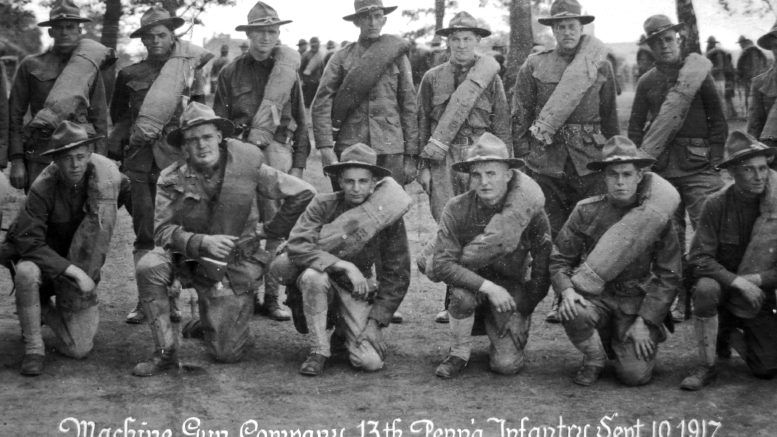World War I will take center stage at the Sayre Historical Society in 2018 with a new exhibit, “The Fight for Liberty: Sayre in World War I”, which will open Saturday, April 7 and run until Sept. 5. A full schedule of events is being planned for the Sayre museum, located in the historic Lehigh Valley Railroad Passenger Station in downtown Sayre.
Returning in 2018 are Celebration at the Station (a wine and craft beer tasting event) on May 23, Caboose Day on June 30 and a genealogy program and workshop on July 28. Other events include History Under the Stars on Aug. 25, History Fair on Sept. 8, Oktoberfest on Oct. 10 and Model Train Day on Nov. 24.
On Saturday, Sept. 8, a new exhibit will focus on “The Art of M. Louis Gore” in the museum’s Rotating Exhibit Room.
The museum board of directors recently held their annual dinner meeting and re-elected the following officers for 2018: President Mike Frantz, Vice-President Ted Pinkard, Treasurer Steve Bowen and Secretary Mary Lou Palmer. Scott Chaffee is assistant secretary / treasurer.
Board members include the officers along with Ken Bracken, Tom Collins, Bill Crocker, Henry Farley, Meade Murtland, Joe Quatrini and Mary Sargent.
The World War I exhibit will include historical information relating to the experiences of Sayre people in what was called “The Great War”.
Highlights of the exhibit will include the area’s first casualty of the war, Archie T. Hatch in 1914, the formation of a machine gun company in Sayre in 1916, a Red Cross Canteen in Sayre in 1918, and the Welcome Home Parade and dedication of the Dough Boy monument in Howard Elmer Park in 1919.
A bronze tablet on the monument contains the names of the 12 Sayre men who died during the war. They are Archie Hatch, Orlando M. Loomis, Eugene F. Murphy, Leo A. Murphy, Arthur V. Drake, Fred D. Skiff, Clarence B. Utter, Elmer D. Jackson, William H. Decatur, Wayne E. Horton, Ransom H. Grumme and Frank E. Bower.
A World War I uniform (donated by Eugene Cole) that was used by Nathan Johnson of Sayre, including his helmet and gas mask, will be featured along with a Red Cross uniform belonging to Sarah (Lennon) McMahon. Sarah Harrington, granddaughter of Mrs. McMahon, donated the Red Cross uniform.
According to a history of the World War I Canteen in Sayre, written by Mrs. J.W. Bishop, over 47,000 service members were provided canteen service while their trains stopped in Sayre.
The Canteen volunteers met trains day and night, according to Bishop. At first, coffee and sandwiches were served and then nearby farmers contributed apples, eggs and other produce. Local women baked pies, prepared custards and made bread puddings that were provided each day to the canteen, according to the historical account.
When the armistice on Nov. 11, 1918 ended the war, the canteen continued operating for returning servicemen. Documentation exists for a canteen service as late as July 1, 1919.
The public’s warm regard for the patriotic services of the canteen volunteers was made evident in a newspaper account from the Owego Gazette.
In describing a “victory parade” in Owego, the editor of the newspaper described the formation of Red Cross volunteers who marched in the parade.
“Next came the Sayre Canteen, wonder workers of the war. At the head of the column was a handsome red and white float, featuring Red Cross nurses ministering to a wounded soldier. This was a mighty attractive feature, for it got the crowds all set for the following feature, which was one of the highlights of the whole show. It was composed of about 60 ladies of the Sayre Canteen, uniformed in the canteen regulation light blue and white. They marched in perfect alignment and in perfect step. The Sayre Canteen, composed of workers from Athens, Sayre and Waverly, had already paraded in the big celebrations in Towanda and Sayre, and consequently were trained to the minute for yesterday’s march. Anyway, this one opinion was shared by everybody who passed critical judgment on the parade, and that opinion is that in appearance and style and action, the Sayre Canteen was the finest marching unit in line. It sure was a stunning feature.”
The Sayre Historical Society is staffed by volunteers and is a recipient of funds from the Bradford County United Way and the Bradford County Tourism Promotion Agency.



Be the first to comment on "Sayre museum planning World War I exhibit"